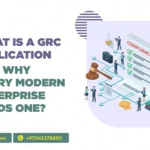At present, businesses are faced with an ever-increasing number of regulatory obligations and operational risks due to the rapid changes in the business world. Therefore, GRC, Governance, Risk, and Compliance frameworks are the ones that most of the firms are taking up as the means of managing these. GRC implementation enables organizations to keep bringing to account, be legally compliant, and unify their processes with the objectives of the company.
It happens that lots of companies are so eager to adopt GRC that they forget to think about it strategically, hence ending up with disorder, waste of resources, and low acceptance. The fact is, GRC is not a mere set of software tools or a rule book; rather, it is the attitude that brings together the trio of governance, risk management, and compliance and sees them through every layer of the business’s daily operations.
In this blog, we shall delve into the realm of GRC and uncover the five most common blunders that companies commit while implementing it, and at the same time, suggest practical solutions that will keep you on the right compliance culture rebuilding path.
-
Considering GRC as a One-Time Project
One of the main blunders that many organizations commit is equating GRC implementation with a one-off event. Most of the companies create the frameworks, go through a couple of audits, and then declare that they have done their compliance duty. The situation is that GRC implementation is not the type of system where you set it and forget it; rather, it is a loop that continuously goes through the stages of monitoring, assessing, and improving.
In reality, when firms run GRC as a short-lived project, they lose the benefits associated with it for the long term. Gradually, this method leads to holes in compliance and the decline of the quality of governance.
How to Avoid:
To circumvent this problem, make GRC an ongoing process rather than a project. Periodically audit your governance policies, compliance requirements, and risk evaluations to maintain their relevance to the latest laws. Set up regular audits and risk control updates as a way of preparing for new challenges. Above all, foster a continuous compliance culture where the employees are aware that governance and risk management are daily operations—not an annual task.
-
Lack of Executive Sponsorship and Cross-Department Collaboration
Being unappreciated as an initiative has no other comparable downside. The GRC journey cannot be supported across the organization and the necessary changes made if these areas are regarded just as the IT or compliance department’s responsibility. Without senior support, the GRC initiatives turn out to be non-existent, without any visibility, and with no required resources for their successful running.
Moreover, when different areas of a company, such as finance, HR, legal, and operations, do not communicate with each other, the data gets split, and the communication gets poorer. This separation, in turn, leads to double work and different risk reports — counteracting the whole idea of having a GRC framework that is completely integrated.
How to Avoid:
The secret lies in the executive buy-in from the very beginning. The management has to be aware that Governance, Risk, and Compliance (GRC) is of direct concern in the areas of business reputation, performance, and regulatory standing. Create a GRC committee involving stakeholders from every department and the functions of the organization.
Promote the flow of communication and place the accountability of the parties through routine updates, performance indicators, and collaborative decision-making. Wherever there is teamwork and sharing of insights, GRC turns into a collective organizational task—not a burden on a single department. Check out our latest blog post on Top 10 Benefits of Implementing a Centralized GRC Application.
-
Picking the Wrong GRC Technology
GRC technology is one of the factors of big importance in the effective management of GRC Implementation in modern times. No doubt, technology is a central element of GRC management, but still, many organizations opt for tools that are either too complex or not tailored to their particular needs. It is the case that sometimes organizations buy very expensive software, thinking that it would be like a magic wand that would instantly make their compliance challenges disappear, only to find that people have a hard time mastering it, or they even give up.
An unsuitable GRC system may lead to isolation of the data, delays in the workflows, and lower acceptance of the system across the company. It can, in fact, make the whole process of compliance harder, rather than easier.
How to Prevent It:
Do not rush into GRC tool selection, but rather spend time determining the right size, goals, and regulatory requirements of your organization first. Think about growth potential—will the tool be able to accommodate your business growth? Select solutions that are compatible with your current systems across ERP, HR, and finance. Also, take into account the user-friendliness of the product; get the feedback of the users during the choosing and testing of the stages, so that they can provide their input on how intuitive and efficient the system is.
By arrangement, a GRC platform can be a new place for everything to go through by making the processes streamlined, by eliminating repetitive tasks, and by enhancing the visibility of the data among the departments. The right technology not only meets compliance requirements but also equips the teams to work smarter and faster.
-
Ignoring Change Management and Employee Training
A lot of companies overlook the change management, and they still think that compliance awareness will come up in a way that is natural. But without regular communication and support, the staff might oppose the new rules, or they might even be completely oblivious to the compliance requirements.
The lack of training results in different ways of working, and there might be misunderstandings regarding who is doing what.
How to Avoid:
In order to develop GRC as the main culture of the company, give primary importance to thorough employee training and change management. Start with putting the purpose and benefits of GRC Implementation —how it will protect the organization and each individual’s role in it—clearly in front of the employees. Run practical workshops and simulations so that the employees can relate the compliance procedures to real-world scenarios.
Along with the above, encourage learning to be continuous through organizing refreshers, providing e-learning modules, and also giving regular updates on changes in regulations. However, the most important thing is to celebrate compliance wins and give praise to the departments that show excellence in governance practices.
-
Not Measuring GRC Effectiveness
When the results of the Governance, Risk Management, and Compliance (GRC) processes are not quantified, top management might lose faith in the system and regard it as a mere cost rather than an investment. This, in turn, gradually deprives GRC of support and thus limits its effectiveness.
How to Avoid:
The method to the solution is through the establishment of Key Performance Indicators (KPIs), which are clear and serve to gauge GRC’s performance. Examples of such metrics are audit closure rates, policy adherence levels, incident response times, and percentage of risk mitigation achieved.
Conclusion
The establishment of a potent GRC Implementation framework can be a game-changer in the way your organization drives risk management, compliance, and governance of its operations. Noticing that success is not only about policies and software—it requires constant effort, good leadership, and a load of responsibility.
Organizations that abstain from the five prevalent errors performed above—e.g., treating GRC as a one-time event, taking the leadership participation lightly, picking the wrong technology, and not training employees—are in a position to develop a GRC tactic that really adds value.
Always keep in mind that the GRC is not only a matter of avoiding sanctions but more so about creating and maintaining trust, honesty, and resilience. Contact us and take the first step by checking your current procedures, spotting the weaknesses, and making small but steady moves towards improvement that never stop.










1 Comment
Comments are closed.